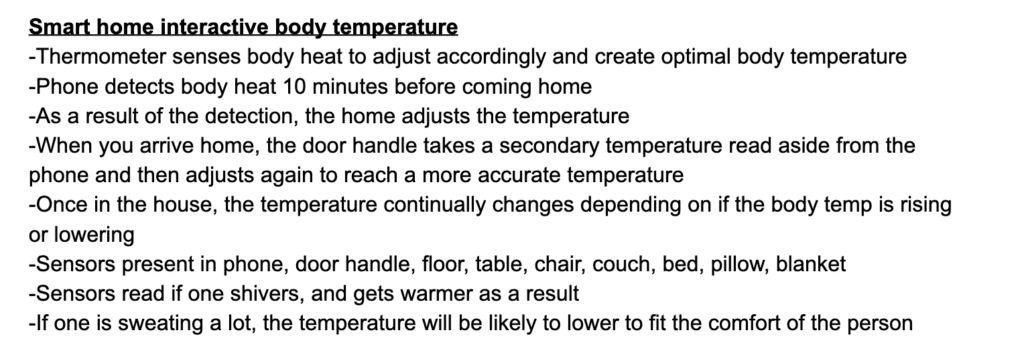My own definition of interaction is an iterative conversation between two or more actors and can be broken down into input, process and output. In addition, interaction varies in levels, which are dependent on the qualities of each stage (input, processing and output). A high level of interaction between human and machine happens as though the machine is an extension of human body and allows for more functions or expressions that are unable to achieve through physical human body.
I came up with that definition based on my and my group’s research and the readings assigned in class. One of the two projects we researched when shaping definition is one interactive media installation called Firewall created by Mike Allison.

This project is engaging and impressive. The visual effects and corresponding change as the user touches the membrane at different depths and with different gestures. I was deeply attracted by it and put myself in the user’s shoe imagining myself playing magic or being a creative artist. Another project I researched is an interactive wall consisting of many buttons which can generate various colors as the user click them. It didn’t impress me that much as the first one.

The difference of my impression on the two projects triggers my understanding of what interaction means. Specifically, as I think through the nature of interaction, the firewall contains many kinds of ways of input and output while the interactive button wall only has one way of input and output although the color produced differs. This relates to the concept “degree of interactivity (Crawford 6)” I’ve learned from Crawford’s article “The Art of Interactive Design,” which thinks of interactivity as a continuous variable. The first project has higher degree of interactivity as it gives the user more ways of input and generates corresponding output based on the certain kind of input. Therefore it adds more complexity and flexibility for the user to interact with. In contrast, the interactive button wall limits the way the user interact with it and gives only one single output, and therefore narrows the degree of interaction. I also gain inspiration from Igoe and O’sullivan’s article “Introduction to Physical Computing” in which they describe computer as “a medium for expression. (3)” Human-machine interaction design nowadays needs us to explore human body’s “full range of expression. (3)” The Firewall project is successful in achieving this. The membrane is extremely sensitive to the depths, speed, and gestures of the user’s hand so the user is allowed more possibility and freedom in moving his hands. Besides, the changing output, be it visual effects or music, gives immediate and unexpected feedback to the user so that the user is encouraged to create more inputs, which corresponds to one part of my definition of interaction— “iterative.” Both projects have input, process and output, but the button wall interaction is a one-time process and not iterative. It’s more of a reaction than an interaction and therefore doesn’t align with my definition of interactivity.
After intensive discussion, our group came up with the definition: Interaction is a continuous conversation between two or more corresponding elements. In designing interactive device we paid particular attention to the “continuous conversation.” Our focus on it derives from the interactive wall project mentioned above, which we think by simply pushing button and generating color cannot be counted as a conversation. Instead, it’s a reaction and therefore is not continuous. Besides, the way of input is simple and boring and requires effort so the user may not be in interest it for long. So we want to create an interactive device that allows more flexibility in input and make the “conversation” ongoing. That’s how we came up with the idea of variable sensors that can take in analog input. And we imagine the input to be continuous variable and is changing from time to time. That’s how we get to the idea of body temperature. Taking into consideration the level of interaction we came up with the idea of automation. Our basic framework of body temperature and automation finally leads us to create a smart house where various sensors can sense the person’s body temperature and adjust the air temperature accordingly fully at automation. To allow for more application, we design those sensors to be not only in house like chairs, couch and bed but also be embedded in the house owner’s phone so that whenever the owner approaches home the phone sensor can send message in advance to the air conditioner (central controller) and the air temperature at home will be adjusted to optimal level before the owner arrives home. Since the body temperature of a person is always changing, so the conversation goes on and on. And the automation requires no effort of the person to initiate that conversation. In addition, various sensors enhances the practicability of the temperature control system. Furthermore, the sensors continuously sending messages to the air conditioner and the air conditioner generates corresponding temperature is also a kind of interaction. Taking all these factors into consideration, I think our interactive design fulfills the assigned criteria, particularly in terms of “continuous conversation.” Here’s a snapshot of our group’s collaboration work on google doc.

Reference
- http://aaron-sherwood.com/works/firewall/
- https://create.arduino.cc/projecthub/natthakit-kim-kang/click-canvas-an-interactive-wall-04332c?ref=tag&ref_id=interactive&offset=0
- Introduction to Physical Computing. https://drive.google.com/file/d/1uviCK0V71cQpA76PV9PK03Df14vcsd0y/view
- The Art of Interactive Design. http://s3-ap-southeast-1.amazonaws.com/ima-wp/wp-content/uploads/sites/3/2017/08/05164121/The-Art-of-Interactive-Design-brief.pdf